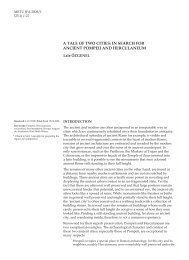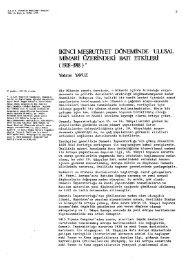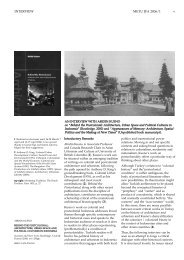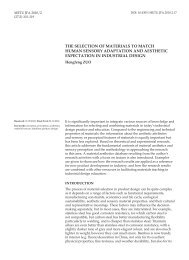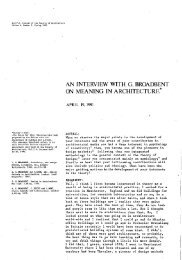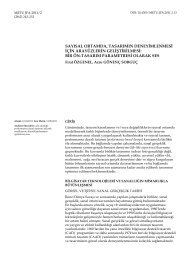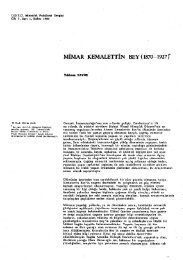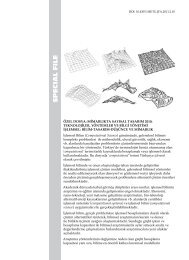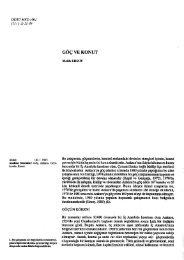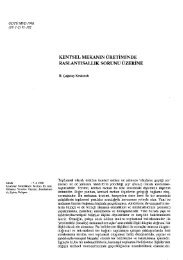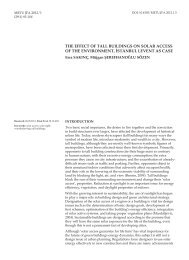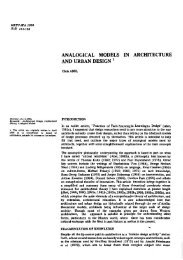Ayşıl YAVUZ Mirçinge Han Ve Selçuklu Dönemi Eşodaklı ...
Ayşıl YAVUZ Mirçinge Han Ve Selçuklu Dönemi Eşodaklı ...
Ayşıl YAVUZ Mirçinge Han Ve Selçuklu Dönemi Eşodaklı ...
Create successful ePaper yourself
Turn your PDF publications into a flip-book with our unique Google optimized e-Paper software.
54 ODTÜ MFD 1991 AYŞIL TÜKEL <strong>YAVUZ</strong><br />
Received : 12. 3. 1993<br />
Key Words; Caravanserai, Anatolian Seljuk<br />
Architecture.<br />
ABSTRACT<br />
Anatolian Seljuk Period caravanserais include a group with concentric plan.<br />
<strong>Mirçinge</strong> <strong>Han</strong> is the last added one to this group which includes six examples at<br />
the present stage of research. <strong>Mirçinge</strong> <strong>Han</strong> is on a secondary route connecting<br />
Divriği yo Malatya, 25 km. to the southeast of Divriği, the seat of a branch of<br />
Mangucheks. The caravanserai has only a shelter, planned in two concentric<br />
rings, the platform for the passengers and the goods in the inner ring and the<br />
stables at the outer ring. The <strong>Han</strong> is not dated but its name is mentioned in the<br />
foundation deed of the Great Mosque of Divriği, which was enacted in 1243 AD.<br />
It is most probably constructed around and before 1230 AD. It is the simplest<br />
and the smallest among the other concentrically planned <strong>Han</strong>s which have<br />
different sizes and number of rings. Their most common characteristic is the<br />
physical separation between the animals and the travellers (with low walls,<br />
complete partition walls, rooms, eyvans) as well as a very apparent desire to<br />
provide more privacy for the travellers in comparison with the other<br />
caravanserais of the Anatolian Seljuk Period.<br />
KAYNAKÇA<br />
ERDMANN, K. (1961) Das Anatolische Karavansaray Des 13. Jahrhundrets,<br />
<strong>Ve</strong>rlag Gebr. Mann, Berlin.<br />
GODARD, A. (1962) L 'Art de L 'Iran, Paris.<br />
KAYALIOĞLU, İ. (1978) Vakfiyenin Değerlendirilmesi, Divriği Ulu Camii ve<br />
Darüsşifast, derleyenler, Y. Önge, İ. Ateş, S. Bayram, Vakıflar Genel<br />
Müdürlüğü Yayınları, Ankara, 10-11.<br />
ODTÜ Mimarlık Fakültesi Restorasyon Bölümü (1967) Doomed by the Dam,<br />
Türk Tarih Kurumu Basımevi, Ankara.<br />
ÖZGÜÇ, T., AKOK, M. (1957) Afşin Yakınındaki Eshab-ı Kehf Külliyesi, Yıllık<br />
Araştırmalar Dergisi (II) 77-92.<br />
REUTHER, O. (1938) Parthian Architecture-History: A Survey of Persian Art, ed.<br />
A. U. Pope, Oxford University Press, London and Newyork, 411-444.<br />
SAKAOĞLU, N. (1971) Türk Anadolu 'da Mengücekoğtılları, Milliyet Yayınları,<br />
Istanbul.<br />
TURAN, O. (1946) <strong>Selçuklu</strong> Kervansarayları, Belleten (X: 39) 471-496.<br />
TÜKEL <strong>YAVUZ</strong>, A. (1969) Alara <strong>Han</strong>'ın Tanıtılması ve Değerlendirilmesi,<br />
Belleten (XXXII: 132) 430-491.<br />
ÜNAL, R. H. (1968) Les Monuments Islamiques de la Ville d'Erzurum et de sa<br />
Region, Librairie Adrien Maisonneuve, Paris.



